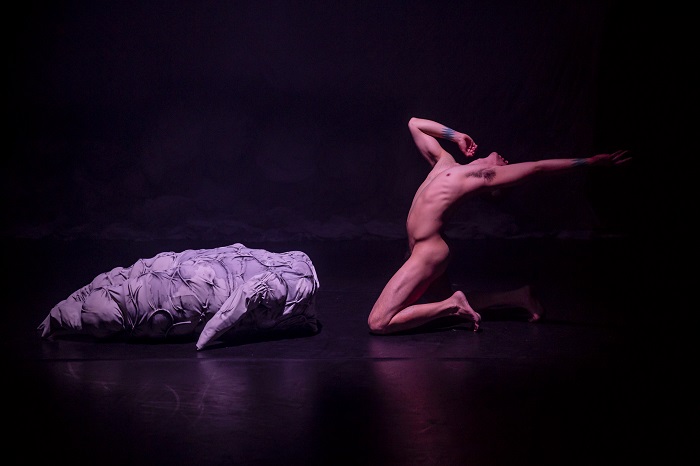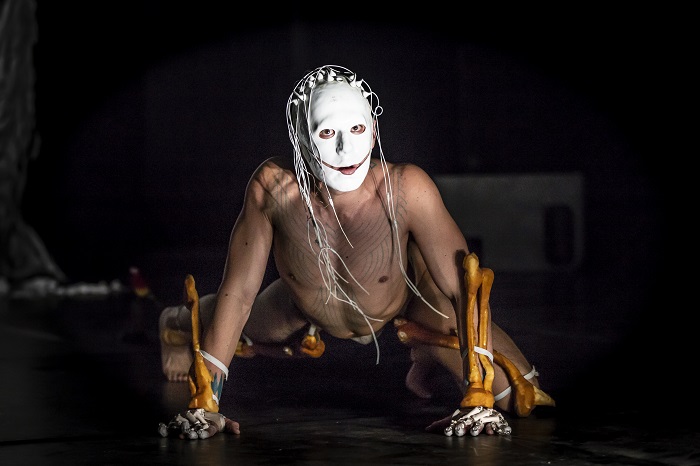The dance-performance piece Carrion performed at Melbourne’s Arts House ran for 60 minutes, and on the evening I attended it was AusLan interpreted. Created by performer Justin Shoulder, Carrion is a work of polarities. At once, exciting and ritualistic; sinister but not scary; naive and sophisticated; internal and exoskeletal; human and post-human.
Carrion is a character. Not dead flesh. They are alive and they are transforming. Yet there is something in them that denotes death, in order to transform they need to shed the old, watch it move away to evolve into something else. There is hope in this evolution, evidence that change is possible despite all evidence to the contrary.
Justin Shoulder has been working for over a decade in Sydney’s queer clubbing scene. I have been following his work for almost two years now. My fascination has endured since early last year when I was delighted by an excerpt of Carrion in Melbourne’s Asia TOPA festival. Carrion satisfied and re-fired this fascination. There is something in the strangeness and old-newness of his work that captivates me.

Carrion by Justin Shoulder. Photo by Bryony Jackson.
The audience first encounters Carrion (the character) as a mollusc or tardigrade-like creature, they writhe and move as the sweeping score begins. Short moments of humour briefly interject as they dart and dance into action: slowly, slowly, suddenly, slowly.
Shoulder’s human body gradually emerges from the mollusc, visible but made strange by its movements and by its birth from this sophisticated puppet. I am struck as I see this human figure before me, as if I had forgotten that of course what I had been watching was always operated by a person, I had believed it was its own life form. This shock is the show’s repetition sensation for me. As Shoulder transforms his body through costume and movement, he is no longer a sole dancer, he becomes many bodies, fluid and changeable. The vibrancy of this work comes from the way it is bodied. Shoulder trusts that his body and the bodies he becomes tell enough of a story. A story that is more felt than understood.
The work is about transforming bodies, transformed by and transformative, visually and ideologically. It alters the body of observers like me as it holds and moves us in its thrall. Onstage, not for the last time, Shoulder changed. He swapped his amorphous mollusc puppet for a costume I can best describe as techno-skeletal, a disconcerting white sheen-plastic mask on his face with headphones attached to form a sparse wig. As I watched he slowly and deliberately strapped bones to his arms and legs. I sat in the audience, bearing witness to this becoming and my body felt changed too.
A booming bass vibrates through my chest and I am woken from a trance that the first act orchestrates. I am alive, and awake, my ears hurt but I am here.
The experience of watching Carrion for me was an aliveness to repeated loss. Of losing track of my body and suddenly, sometimes shockingly finding it again. I was absorbed in Shoulder’s expert control of his puppets and set, but also in the finesse and beauty of his dancing. I would lean forward out of my chair, gasping and crying and laughing. Each time,
watching him, I was thrust back into an awareness of my own body.

Carrion by Justin Shoulder. Photo by Bryony Jackson.
I left feeling a strange sense of my own belonging in the world. That Carrion the character evolved and de-evolved, taking on drastically different forms as the work progressed left me thinking that the way we, especially in the West, perceive of evolution and time is absurd and impoverished. Who are we to say we have reached our “final” evolutionary form, especially as we go about effectively destroying the world around us. We need to change, perhaps go backwards, but to believe this change is impossible is to be stuck in tired ideas. We need something new.
I do not belong to the specific communities from which Shoulder’s work emerges and therefore I must acknowledge that perhaps this type of work is only ‘new’ for me. Regardless, nothing has excited me as much recently as this piece. To centralise the body is to offer a different way of thinking and of being. There is here an injection of something other, something strange and complex. Simply put, this is so much more interesting and challenging than iterations on the same theme that make up so much of Australia’s mainstream theatre programming. This is moveable and exhilarating, this has a long history but it is the future.
Rating: 5 stars ★★★★★
Carrion
Lead Artist: Justin Shoulder
Composer: Corin Ileto
Mentor & Artistic Collaborator:
Costume & Set Designers: Matthew Stegh, Justin Shoulder
Lighting Designer: Benjamin Cisterne
27-30 June, 2018
Arts House, Melbourne





